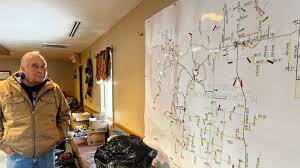News Based on facts, either observed and verified directly by the reporter, or reported and verified from knowledgeable sources.
South Dakota responds to criticism, says it answered tribal storm needs
 Wayne Boyd, chief of staff to the president of the Rosebud Sioux Tribe in South Dakota, looks at a map showing cleared and uncleared roads on Dec. 27, 2022, after winter storms. (Joshua Haiar, SD Searchlight)
Wayne Boyd, chief of staff to the president of the Rosebud Sioux Tribe in South Dakota, looks at a map showing cleared and uncleared roads on Dec. 27, 2022, after winter storms. (Joshua Haiar, SD Searchlight)
The state has responded to Rosebud Sioux Tribe officials’ frustrations with its response to recent winter storms.
The tribe issued an emergency declaration in response to the storms, which partially buried homes across the reservation and resulted in at least six deaths.
The deaths occurred both before and after a National Guard deployment ordered by Gov. Kristi Noem, which came six days after Rosebud Sioux Tribe President Scott Herman made his emergency declaration.
State officials, however, said this week that its emergency response crews began coordinating with Rosebud and the state’s other tribes before the first storm began on Dec. 13.
The state Department of Public Safety reached out to emergency managers at all nine tribes in the state, including Rosebud, on Dec. 12, according to Secretary Craig Price.
“We were helping before their emergency declaration and have continued to provide assistance since,” Price said in a statement sent Wednesday evening.
On Thursday, DPS spokesman Tony Mangan sent a timeline of events that begins with the coordination call on Dec. 12. In it, the DPS also outlines conversations between Rosebud officials and state officials on Dec. 16, the day Herman signed the tribal disaster declaration and Noem issued a disaster declaration to speed deliveries of propane and heating fuel statewide.
Herman spoke with Tribal Relations Secretary Dave Flute that day and told him that “any assistance would be appreciated,” according to the DPS timeline. Jason Bauder of the state Office of Emergency Management spoke with Rosebud Emergency Preparedness Program Coordinator Robert Oliver that day, as well.
The state’s timeline notes that Rosebud officials declined help with dialysis patients and “had no other resource requests” on Dec. 17 after being connected with a contractor for snow removal. The timeline quotes Oliver telling Bauder that the tribe “was fine with the equipment that it had leased/purchased.”
Price and other state officials spoke with Herman again on Dec. 20 about the tribe’s needs for snow removal and firewood, according to the timeline. The state continued to work on firewood deliveries.
Wood, propane and food were delivered on Dec. 21, the timeline said. On Dec. 22, Noem activated the National Guard, which sent heavy snow removal equipment to the reservation and continues, along with state OEM staff, to work across Rosebud.
“Communication remained robust and consistent throughout, up to this very day,” according to a statement attached to the timeline. “Every need that the tribes articulated was addressed.”
South Dakota Searchlight initially requested information on the state’s response to the storm over the phone on Tuesday, Dec. 27, after nearly three hours of in-person interviews with Rosebud officials.
Noem spokesman Ian Fury, who did not respond to emailed and texted requests for comment on Wednesday about the situation in Rosebud, tweeted about the Searchlight’s coverage at noon on Thursday, and tweeted the timeline sent to Searchlight a few hours later.
Herman disputes parts of the timeline and said the state did not reach out to Rosebud officials on Dec. 12.
“Our timelines don’t jive,” Herman said.
Herman said the tribe’s first contact with the state was Dec. 13 or 14 when he called the Office of Tribal Relations to give Dave Flute a brief about the situation.
Other parts of the state’s timeline are missing context, Herman said. The tribe did tell the state it didn’t need help with dialysis patients and “had no other resource requests” on Dec. 17, but the tribe still needed help delivering those resources and clearing roads, according to Herman.
When Oliver told Bauder the tribe “was fine with the equipment that it had leased/purchased,” Herman said, that was because the tribe had expected three plows to arrive – but only one showed up, and it was only available for a day and a half.
Herman’s frustration was not only with the state, but also with the federal government and private contractors as he and other tribal officials scrambled to get assistance responding to the storms. It took two weeks to get all the assistance the tribe needed, and he said the effect of that delay was evident in the six deaths.
And despite the difficulties, Herman said, the tribe is grateful for the assistance the state provided.
This article was first published in South Dakota Searchlight.
